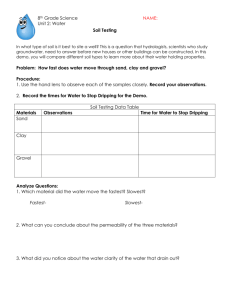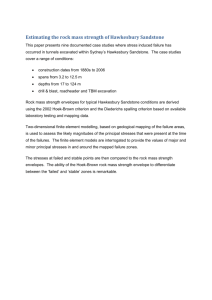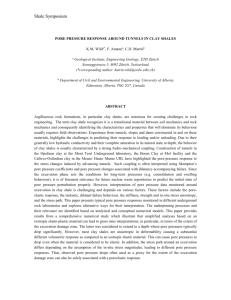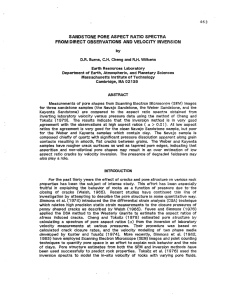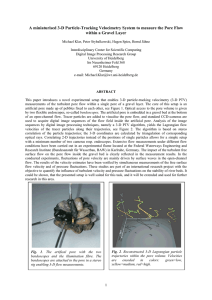Tute_3_Effective_str..
advertisement
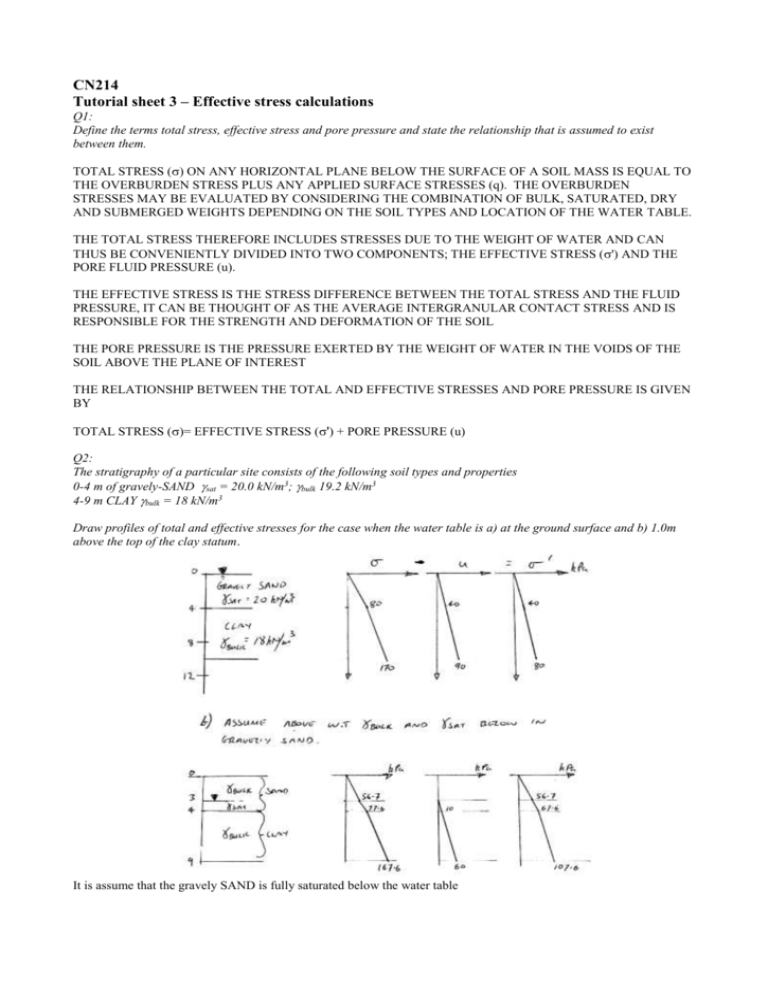
CN214 Tutorial sheet 3 – Effective stress calculations Q1: Define the terms total stress, effective stress and pore pressure and state the relationship that is assumed to exist between them. TOTAL STRESS () ON ANY HORIZONTAL PLANE BELOW THE SURFACE OF A SOIL MASS IS EQUAL TO THE OVERBURDEN STRESS PLUS ANY APPLIED SURFACE STRESSES (q). THE OVERBURDEN STRESSES MAY BE EVALUATED BY CONSIDERING THE COMBINATION OF BULK, SATURATED, DRY AND SUBMERGED WEIGHTS DEPENDING ON THE SOIL TYPES AND LOCATION OF THE WATER TABLE. THE TOTAL STRESS THEREFORE INCLUDES STRESSES DUE TO THE WEIGHT OF WATER AND CAN THUS BE CONVENIENTLY DIVIDED INTO TWO COMPONENTS; THE EFFECTIVE STRESS (') AND THE PORE FLUID PRESSURE (u). THE EFFECTIVE STRESS IS THE STRESS DIFFERENCE BETWEEN THE TOTAL STRESS AND THE FLUID PRESSURE, IT CAN BE THOUGHT OF AS THE AVERAGE INTERGRANULAR CONTACT STRESS AND IS RESPONSIBLE FOR THE STRENGTH AND DEFORMATION OF THE SOIL THE PORE PRESSURE IS THE PRESSURE EXERTED BY THE WEIGHT OF WATER IN THE VOIDS OF THE SOIL ABOVE THE PLANE OF INTEREST THE RELATIONSHIP BETWEEN THE TOTAL AND EFFECTIVE STRESSES AND PORE PRESSURE IS GIVEN BY TOTAL STRESS ()= EFFECTIVE STRESS (') + PORE PRESSURE (u) Q2: The stratigraphy of a particular site consists of the following soil types and properties 0-4 m of gravely-SAND sat = 20.0 kN/m3; bulk 19.2 kN/m3 4-9 m CLAY bulk = 18 kN/m3 Draw profiles of total and effective stresses for the case when the water table is a) at the ground surface and b) 1.0m above the top of the clay statum. It is assume that the gravely SAND is fully saturated below the water table Q3: For the site profile below draw total and effective stress profiles for the following conditions: a) water table at the ground surface, and b) water table at a depth of 2.5m assuming the silty sand stratum above the water table to remain saturated with capillary water (i.e negative pore pressures are present). Saturated unit weights: silty sand = 18.5 kN/m3 Depth (m) 0-5 5-9 >9 clay = 17.7 kN/m3 Strata Silty sand Peaty clay Rock (impermeable) We assume that the capillary forces in the silt above the water table result in negative pore pressure being generated which in turn results in increased effective stresses. However, you should recognise that it is unlikely that negative pressures can be maintained for long in the field due to moisture ingress and so should not be relied on in a design situation. Q4: The strata in the flat bottom of a valley consist of 3m of coarse gravel overlying 12m of clay. Beneath the clay is fissured sandstone of relatively high permeability. The water table in the gravel is 0.6m below the ground level. The water in the sandstone is under artesian pressure corresponding to a standpipe level of 6m above ground level. The unit weights of the soil are: Gravel - above water table - below water table (saturated) Clay - saturated 16 kN/m3 20 kN/m3 22 kN/m3 Plot total stresses, pore water pressures and effective vertical stresses against depth for a) with initial ground water levels b) assuming that the water level in the gravel is lowered 2m by pumping, but the water level in the sandstone is unchanged c) assuming that the water level in the gravel is kept as for (b), but that relief wells lower the water pressure in the sandstone by 5.5m. d) Assuming that the relief wells are then pumped to reduce the water level in the sandstone to 15m below ground level. Note that for (b), (c) and (d), strictly speaking stresses are required for the short-term and long-term conditions.
